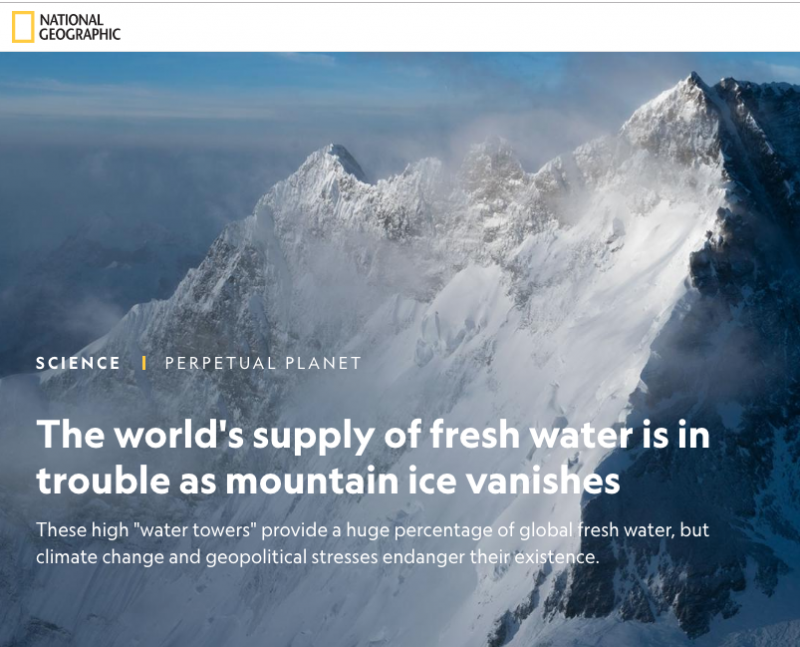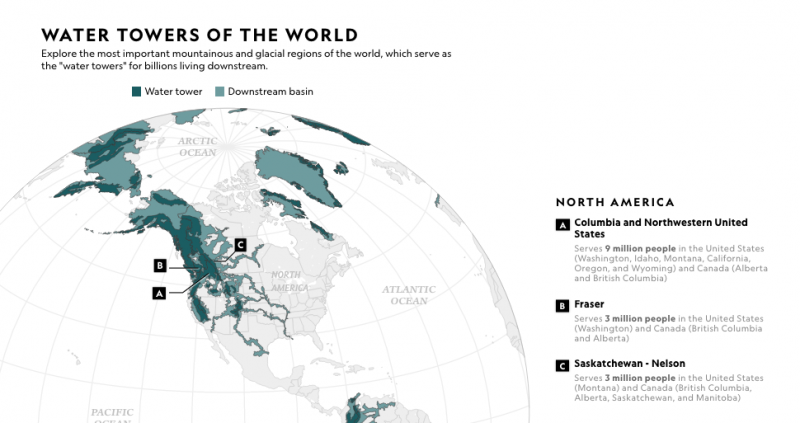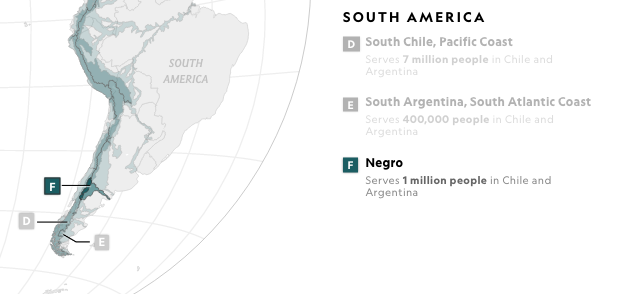The world's supply of fresh water is in trouble as mountain ice vanishes
Published on by Water Network Research, Official research team of The Water Network in Academic
 HIGH IN THE Himalaya, near the base of the Gangotri glacier, water burbles along a narrow river. Pebbles, carried in the small river’s flow, pling as they carom downstream.
HIGH IN THE Himalaya, near the base of the Gangotri glacier, water burbles along a narrow river. Pebbles, carried in the small river’s flow, pling as they carom downstream.
This water will flow thousands of miles, eventually feeding people, farms, and the natural world on the vast, dry Indus plain. Many of the more than 200 million people in the downstream basin rely on water that comes from this stream and others like it.
But climate change is hitting those high mountain regions more brutally than the world on average. That change is putting the “water towers” like this one, and the billions of people that depend on them, in ever more precarious positions. New research published Monday in Nature identifies the most important and vulnerable water towers in the world. The research creates a template for world leaders—many of whom gathered at a major annual climate summit last week—to follow as they consider how to prioritize climate adaptation efforts in the face of unprecedented, rapid change.
“We all need water. We’re 90 percent water, we require fresh water,” says Michele Koppes, a climate and glacier scientist at the University of British Columbia and an author of the report. “We have big demands on the water from these water towers, and we have to understand better how they’re changing.”
Why do we care about water towers?
The high mountains cradle more ice and snow in their peaks than exists anywhere else on the planet besides the poles. Over 200,000 glaciers, piles of snow, high-elevation lakes and wetlands: All in all, the high mountains contain about half of all the fresh water humans use.
The snow and icy glaciers that drape the high mountains play a crucial role for over 1.6 billion people—over 20 percent of Earth’s human population today—whether or not they know it. The water you’re drinking may in fact have come from a high-mountain source.
The high-mountain “water towers” of the planet act like giant storage tanks with valves on them. The system more or less works like this: Snow falls, filling the tank, and then it melts out slowly over days, weeks, months, or years—a natural valve that smooths out the boom-bust pattern in outflow that would otherwise occur.


For decades scientists have recognized that climate change will affect the amount of water stored in the high mountain water towers and the paths it takes as it flows out. The high mountains are warming faster than the world’s average; temperatures in the high Himalaya, for example, have crept up nearly 3.6 degrees Fahrenheit (2 degrees Celsius) since the beginning of the century, compared to a planetary average of just about 1.8 degrees F (1 degree C).
Small changes in the amount of water coming out or the timing could, they predicted, add great stress to communities already struggling to use water prudently. That would be true, they thought, for small communities, like the potato farmers of the upper reaches of the Indus, as well as major desert cities that rely on water tower water, like Lima, as well as for entire countries who were already in conflict over water rights, like India and Pakistan.
But until now, no one had quantified the relative importance of each water tower in the world—in other words, how critical the water flowing from those regions is to the populations downstream. Nor had they created a full global reckoning of the vulnerability of each of those water towers to the host of factors that might affect them: changing climate, increasing development and associated rises in water use, geopolitical instability, and more.
“This is really ringing a bell about the sensitivity of these mountain regions to climate change and other stresses,” says Justin Mankin, a climate scientist at Dartmouth who was not involved in the research.
The research team decided that the “importance” of the water towers was a function of two factors: the supply in the high elevation areas and the demand downstream. If a water tower has plenty of water resources—in the form of snow, ice, or liquid water—it has high supply. If downstream demand on that supply is also high, from activities like agriculture, cities, and towns, and industrial use, then the water tower is considered important. The Indus River is the world’s most important, within this framework.
“120 million people live along the Indus,” says Immerzeel, “but the Indus plain is like a desert. It’s completely reliant on the water from the thick glaciers above.”
Of the five most important water towers in the world, three are in Asia: the Indus, the Tarim, and the Amu Darya.
In North America, British Columbia’s Fraser River and the Pacific Northwest’s Columbia water tower regions rank most important. In South America, the Cordillera Principal, the Cordillera Patagónica Sur, and the Patagonian Andes are highly important; and in Europe, the Alps provide critical water supplies.
Africa and Australia don’t appear in the importance list because their snowy mountains don’t provide a critical source of water for big population centers like the high mountains of Asia and South America do.
The future stresses are probably bigger
What will happen with these water towers in the future? Which are most vulnerable to the host of increasing stresses?
Climate change will affect the size and shape of glaciers in the high mountains, as well as the amount and type of precipitation that falls. In many cases, the total amount of liquid falling from the sky might actually increase—but not necessarily enough to offset the loss from melting glaciers.
SOURCE COMPLETE ARTICLE NATIONAL GEOGRAPHIC
Nearby Mount Everest, Lhotse is the fourth highest mountain in the world. PHOTOGRAPH BY MARK FISHER
Media
Taxonomy
- Glacier